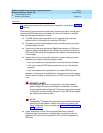
MERLIN LEGEND Communications System Release 6.1
Network Reference
555-661-150
Issue 1
August 1998
Call-Handling Scenarios
Page 2-11Networking Guidelines
2
far (over 200 miles) connections and between 21 and 40 for near (under 200
miles) connections. DEFINITY ECS and DEFINITY ProLogix Solutions systems
are identified by numbers between 41 and 50 for far connections and between 51
and 60 for near connections.
With a given private network system, all the trunks that connect to another specific
system must have the same switch identifier number. For example, if two T1-
emulated tie trunks connect System B to System A, System A’s manager must
ensure that both of those tandem tie trunks are labelled with the same switch
identifier, which is different from the switch identifier that labels a third trunk
connecting System A and System C.
It is strongly recommend that each system have a unique pair of identifiers for far
and near. If the switch identifiers are not correctly programmed, routing is
disrupted. For example, when the switch identifier of the incoming trunk and the
automatically selected outgoing trunk for a call match, another route for the call is
selected if possible. However, if all available routes specify systems with matching
switch identifiers, the caller hears a fast-busy tone. Otherwise, the call would be
routed back to the originating system in a continuous loop. This is called
automatic immediate cycling
.
A trunk that is not a tandem trunk has no switch identifier; this is the factory setting
for all trunks. This is how the switch distinguishes tandem trunks from central
office lines. To remove a switch identifier, see “Switch Identifiers” on page 19
.
PRI tandem trunks require special programming, much of which is automated for
you when a PRI switch type of MERLIN LEGEND-PBX or MERLIN
LEGEND-Ntwk is chosen. The switch type for the system
at the other end
of a PRI
tandem trunk is selected during system programming. When MERLIN LEGEND
Communications Systems are networked, the switch types at each end of a
tandem PRI trunk are different. The scenarios provide examples. See “Tandem
PRI Facilities” on page 22 for details.
In Release 6.1 and later systems, the PRI Switch Type Test requests the system
at the other end to verify that the correct PRI switch type is programmed. This test
should be run only by Lucent Technologies technicians or authorized
representatives.
In Release 6.0, outside PRI dial-plan routed and DID calls can be routed to non-
local extensions. In Release 6.1 and later systems, this capability has been
expanded to all types of PSTN trunks by using calling groups with a single non-
local member. Most of the scenarios in this chapter provide examples.


















